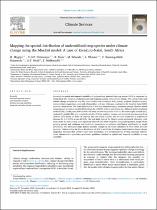| dc.description.abstract | Knowing the spatial and temporal suitability of neglected and underutilised crop species (NUS) is important for
fitting them into marginal production areas and cropping systems under climate change. The current study used
climate change scenarios to map the future distribution of selected NUS, namely, sorghum (Sorghum bicolor),
cowpea (Vigna unguiculata), amaranth (Amaranthus) and taro (Colocasia esculenta) in the KwaZulu-Natal (KZN)
province, South Africa. The future distribution of NUS was simulated using a maximum entropy (MaxEnt) model
using regional circulation models (RCMs) from the CORDEX archive, each driven by a different global circulation
model (GCM), for the years 2030 to 2070. The study showed an increase of 0.1–11.8% under highly suitable (S1),
moderately suitable (S2), and marginally suitable (S3) for sorghum, cowpea, and amaranth growing areas from
2030 to 2070 across all RCPs. In contrast, the total highly suitable area for taro production is projected to
decrease by 0.3–9.78% across all RCPs. The jack-knife tests of the MaxEnt model performed efficiently, with
areas under the curve being more significant than 0.8. The study identified annual precipitation, length of the
growing period, and minimum and maximum temperature as variables contributing significantly to model
predictions. | en_US |

